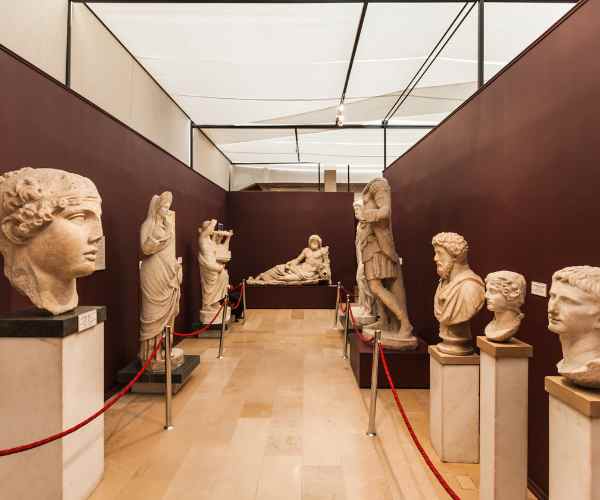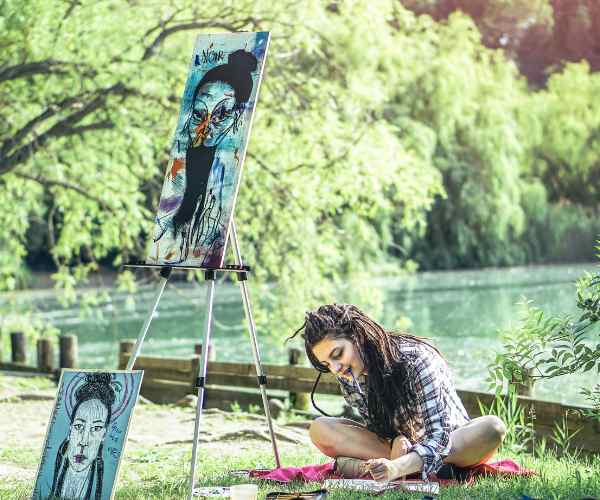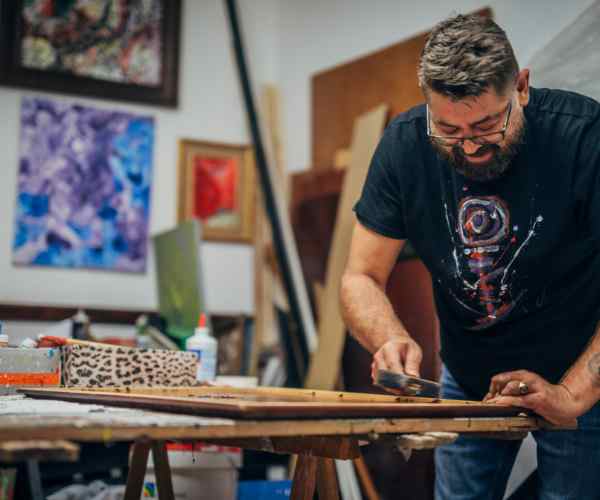Art museums and galleries have an extraordinary capacity for providing inspiration; if only we could use this to change how we see everything.
The first time I entered the Louvre is a memory etched in my mind.I recall it vividly. It was akin to being enveloped in a dream; one that was rich with centuries-old expressions and creativity of mankind. The magnitude of the museum and history that resided in it left me in complete awe. It is astonishing how art possesses the capacity to inspire such creativity and implore ideas to be born.
There is a common theme within all pieces of art; be it Van Gogh’s dramatic brush work or the calm expressions of a classical sculpture, it invokes feelings. It urges one to connect with the creation on a deeper level, and seek the tale that gave it form.
There is an abundance of art-loving people ranging from international blockbuster exhibitions to the corner in locals galleries and, there is something for everyone. You do not need to be a fountainhead critic nor do you need to be any type of artist to appreciate the beauty these places hold, art is present for everyone to bask in. All of them await us, yearning to motivate, invigorate, and inspire.
In this blog post, we’ll talk about the use of art by art museums and galleries as strong means of inspiration. You will notice these sights not only promote creativity but also serve as a starting point for our own creative endeavors.

The Role of Art Museums in Inspiration Creativity
Historical Context
For centuries, art museums have been an epicenter of inspiration.
These are the places that millions of people have visited. They have traveled through the grande halls of the Louvre in France or the Metropolitan Museum of Art in New York in a bid to enjoy the different types of artefacts. These serve institutions serve a larger purpose than just art: they change the way we feel or think.
Let’s take the Mona Lisa, for example. For centuries, artists, writers, and even normal visitors have traveled from across the globe to view a painting that sits in the Louvre. Due to the intricate composition of the painting, there have been numerous interpretations and heated debates about her enigmatic smile. Isn’t it amazing to think that one single piece of art can steer an entire movement? Not just in art, but even in literature and philosophy?
And there is the Met. History and culture are the most powerful forces in the world, and this establishment is more than just a museum, it is a culmination of them. Its an extraordinary collection with a history of over 5000 years containing everything from ancient to modern culture. This enables the audience to immerse themselves in new thoughts and ideas.
These museums highlight art’s evolution, for it is the combined efforts of the artists that change it. Once we step into these spaces, we aren’t spectator of art – we are part of a harbored conversation that surmounts across time and space.
Artistic Influence
What does real-life inspiration entail? To put it simply, there are myriad accounts of individuals who discovered their muse inside a museum. One such passionate artist is Georgia O’Keeffe who often frequented southern galleries. There she was able to be influenced by the paintings of her peers. It was within the these same surroundings that she started constructing her signature look that would eventually change the dynamics of American modernism.
A similar perspective is also shared by authors who visit museums and galleries for inspiration. I once quarreled with a poet acquaintance who claimed to witness an aesthetically conglomerated gallery containing Abstract art which curved her perception of languages and images. Such warm colors along with distorted geometric shapes were new of her, leaving her with novel feelings that could be expressed via poems. As such, she got encouraged to utilize such artwork along with her writings in compiling vivid dreams.
Even yun netari find art and inspiration at museums. Some art I once saw a local band that did a fusion performance at a gallery and eh there as well. Artworks affects particular visuals that i saw where the artworks ebm categorized and specialized, making the rest much more compelling.
These tales illustrate that museums are never just for the appreciation of artistic works but also for the motivational force that artists need to have. They help one ignore boundaries and foray into uncharted territories in terms of ideas as well as their own art forms. When one goes through the doors, one is taken to a world where inspiration has no limitations.
How are galleries changing the contemporary art practice and where do artists get inspiration from?
Cultivating New Voices at the Centre of Studios
Galleries are so important in the world with the help of whom many new children artists of today are brought up and new trends observed.
A small gallery in my hometown that was opened by a group of artists who were yet to be fully recognised is something I will never forget about. Everything that was put on the wall was a work in progress telling stories for the sake of artist. The work felt more real, lacks a sense of polish than the others but rather than all polished and of course over commercialized like most other institutions.
Galleries that specialise in unknown artists and turn a decent profit have a charisma of their own, providing people with a chance of being seen that would usually be over looked and missed. These artists, quite often, tend to break barriers and dig into new ideas that are outside the box.
What’s the best part about such galleries is how it does more than just display art, it serves as a platform for a new breed of creators, highlighting their efforts and intrigiues art enthusiasts. It takes just a single visit to spark a zillion ideas. The simplest thing could do the trick, be it random color usage or unique perspectives on subjects. For instance, there’s this one instance that lingers in my mind where after I saw a series of paintings, I started considering how I could be sustainable and eco friendly with my own work. There’s so much variety available out there, it doesn’t come off as a surprise that innovative concepts come into light all the time.
The Community Aspect
Besides providing exposure to new shouters and unheard of names, galleries serve the purpose of assisting in building a strong circle of collaboration that includes multiple artists and showcases their work.
A fair share of collaborative exhibitions where multiple different artists collaborated to work towards a single goal exist. My personal favorite was a local exhibition which aimed to raise awareness towards environmental issues. Although the pieces were all aimed towards climate change, the gallery hosted talks, classes and even motivated the community to come together and make a difference.
Local initiatives and conversations are ignited with the help of these collaborative exhibitions. Many artists, who were once reclusive, begin to feel like they are part of a lively society. This can result in strong alliances and innovative undertakings since they exchange concepts, skills, and motivation with one another.
For example, a few artists I’m acquainted with began working together on murals throughout the city after we met at a gallery opening. Walls that previously were bare became canvases for a celebration of connectedness and a sense of optimism because of their collaborative vision. This interaction is fascinating since it shows that galleries can be more than just a platform for expressing art – they can also be a space for demonstrating and fostering community and even social transformation.
Your Imagination In Action: Looking For Inspiration In Museums And Galleries
Getting in Touch with Art
At this instance in time, we should engage in the topic of how one should best approach their trips to museums and galleries.
First temporal consideration is the most important, especially when dealing with monumental constructs. One of the disadvantages in going to a bigger museum is that timeframes can get crammed a little so take breaks, so you’re able to go to each piece and get an idea of the overall topic. I usually devote an entire afternoon only to meandering around, soaking up all the intricate particulars of each work.
It is necessary for us to take a break, especially if we stumble onto a piece that we can relate to and find appealing. Utilizing the right questions, such as what story does the piece tell me, lets us tackle the exploration of the art in an effective manner. This helps in shaping the interaction well, allowing us to bring personalization to the mix.
I’ve also found that sketchbooks and journals can come in handy in those moments. Taking down notes, drawing up that motivational piece, and even crafting a poem for something that has captured your interest can prove beneficial. This not only aids in the comprehension of the experience but can turn out to be useful for the future.
Interactivity in Exhibits
Interactive exhibits are without a doubt one of the fastest growing trends in the art industry.
These installations encourage visitors to be part of the creativity, and blur the boundaries that have existed between the art and the viewer. I recall walking into an exhibit in which you were able to enter a room filled with strips of fabric of varying colors that were all hanging from the ceiling. The fabric would sway around me as I walked around the room and I was transported in an artistically interactive world. It was a moment filled with creativity and brilliant sensations.
Artistic activities such as interactive art installations make one feel the profound depths of inspiration. Rather than being passive witnesses, these installations enable us to become a part of the work. There are individuals who have taken pictures, started to dance or even engage in their mini shows in such locations, which is another form of creativity embedded into the experience.
FAQ
What kind of art is available in museums and galleries?
You do not just go into the art museum or gallery only expecting just one art but instead an array of rich blend of arts that is able to capture the senses.
An art museum is also coarse with artwork and often includes painting, sculpture and photography of enormous proportions and done by famous artists today and from centuries ago.
For instance, a MoMA visit in New York City displays a range of artistic genres such as Van Gogh’s dark sky paintings to modern exhibits. It’s the same kind of journey that all the exhibits provide, but the rhetoric and context change: everything has its history and its own cause.
In contrast, I know that galleries are inclined toward the showcasing of modern-day art. Such areas are ideal for the viewing of new art pieces or multi-media works. I recall of coming across a local gallery, which had an interactive light installation. Green color was projected from the gallery ceiling on specific spots on the interactive installation. It created a narrative between the piece and the audience. Such art compels you to consider, to move around and interpret, thus, making the next visit another novel experience.
How can art museums help with self improvement?
Going to art museums is an adventure. It is a journey to a different world and it can change you completely. Museums give new vision and make one contemplate.
Consider this: standing close to an insightful piece of work; you are currently seeing a picture which invokes strong feelings, for instance, an artwork can evoke feelings of longing or a sculpture may set off an inventive idea or inspiration. Such feelings can trigger changes inside you that help in achieving a new level of understanding of one’s feelings and experiences.
I remember going to an exhibit that focused on the issue of mental health. The paintings and sculptures put together by the artists telling their stories touched my heart. They stemmed from undiscovered intuitive parts of my recollections enabling me to connect with everyone through those memories. It felt as though the painters were talking to me directly encouraging me to feel more and to create.
Art galleries allow us to think differently, they help us feel things we may not want to feel. And this kind of self exploration results in evolution and growth as human beings
Are art galleries exclusively for art lovers?
Absolutely not! Art galleries are for all people irrespective of what they do and their experience with art.
Many people tell me, “I know nothing about art”, and I think this is the best aspect of the galleries, since no one is excluding anybody. Everyone has a place in these spaces, whether you are an art lover or someone who simply enjoys beauty and creativity.
I would like to share my experience of taking my friend to an opening event at the gallery. It still baffles me how nervous and anxious she was before the event. Know that it was her first time at the gallery and her initial assumption about the experience was that she would not understand anything in there. But to her surprise, story telling was an integral part of the exhibition and over time as we meandered through the different pieces, she was able to connect with the emotions each artwork was able to evoke. And I still recall how excited she was by the very end of the evening. It was quite empowering to watch her thinking outside of the box and being able to connect with creativity in a way which she never thought possible.
Galleries serve as the local lounges for communion, discussion and networking opportunities. They call upon all societies in a bid to experience art and promotes fellowship and creativity that has the ability to reach out to all people regardless of their backgrounds.
Conclusion
The potential and strength that art museums and galleries have is unquestionable, when it comes to inspiration.
These spaces act as bridges connecting people to new ideas, emotions and to greater ‘things’ that enrich our lives. Every time you go to the doors of a museum or a gallery you go for a voyage of adventure. You open your eyes to new angles, different feelings and people around who are interested in art.
Do not hesitate to look for art centers in your area, they could be an impressive museum or a little gallery down the road, every single trip can prove to be helpful in a way you didn’t anticipate, in terms of inspiration.
You and your friends should totally indulge in artwork it is sure to blow your mind away, inspiration could be sitting right beside you.



